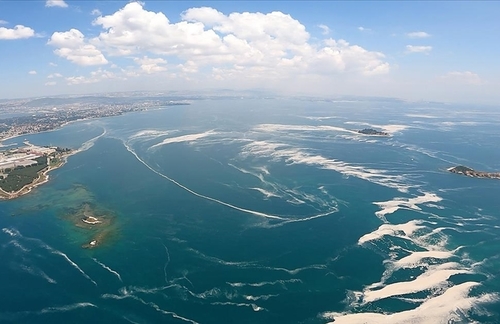Marmara Sea covered with “sea snot” in 2021. (Photo: AA/File)
Concerns are mounting as experts warn that the oxygen-depleted layer at the bottom of the Marmara Sea in northwestern Turkey is expanding towards the surface, potentially leading to a “disaster” if pollution continues unchecked.
According to data from the Middle East Technical University’s (METU) Institute of Marine Sciences, the oxygen level in the first 30 meters of the Marmara Sea, where the Black Sea water is present, measures 8-9 milligrams per liter, while it drops to 1-2 milligrams per liter in the Mediterranean water starting from 30 meters, and even below 1 milligram per liter in the layer between the seafloor and 300 meters.
These figures indicate that many fish species cannot survive beyond 30 meters deep in the sea.
The Marmara Sea is bordered by the less saline Black Sea to the north and the more saline Ege Sea, which is an embayment of the Mediterranean Sea, to the south.
Drastic decrease in oxygen levels
According to the long-term data compiled by METU’s Marmara Sea Integrated Modeling System (MARMOD) Project for the deep waters of the Çınarcık Depression in eastern Marmara, oxygen levels that were above 2 milligrams per liter in the 1980s have now dropped to below 0.5 milligrams per liter.
Prof. Mustafa Yücel, vice director of METU Institute of Marine Sciences, told Anadolu Agency (AA) that oxygen dissolves in water in smaller quantities at certain temperature and salinity levels, and the oxygen in the bottom waters has significantly decreased over the past 30-35 years.
“Currently, the bottom waters in the Eastern Marmara are almost oxygen-free. Deoxygenation has spread upwards in recent years, and the oxygen level drops below 2 milligrams per liter after 25-30 meters,” he said.
He emphasized that the decrease in oxygen levels to below 2 milligrams per liter makes it impossible for most commercial fish species to live in these waters, causing them to escape elsewhere.
Pollution and overfishing
Prof. Barış Salihoğlu, director of METU Institute of Marine Sciences, described the Marmara Sea as a sensitive region that has historically experienced intense human pressure, which has been increasing over time. He identified the highest pressures as pollution and overfishing. Salihoğlu stated, “The pressure of climate change is also substantial, as it is a global issue strongly felt in the Marmara region.”
He pointed out that the Marmara Sea is significantly influenced by the Black Sea to the north, and the control of pollution coming from the Danube River has reduced this impact, but the pressure from the surrounding cities has increased.
Salihoğlu emphasized that if pollution were to be reduced by half, the water flowing from the Mediterranean to the Marmara Sea would raise the oxygen levels to the targeted threshold within five to six years. However, if the water from the Mediterranean is restricted or pollution increases, it could lead to a disaster for the Marmara Sea, which would rapidly return to the state of the Black Sea.
To avoid the worst-case scenario, Salihoğlu stressed the urgency of upgrading all wastewater treatment systems to advanced treatment and cleaning the 11 rivers flowing into the sea.
He said, “The rivers flowing into the Marmara are highly polluted, and there is a significant pollution input from the Susurluk Basin. If these inputs increase, the Marmara may become a dead sea. It is in a bad condition now, and I hope we won’t reach a much worse situation.”
“Sea snot” may recur
Salihoğlu warned that failure to take action against pollution could result in more events such as mucilage, increased jellyfish numbers, and harmful algal blooms emitting toxic gasses.
In 2021, the Marmara Sea experienced a major mucilage issue, with large stretches of the sea covered by a thick layer of mucilage, also known as “sea snot” reaching up to 30 centimeters in some areas.
This issue occurred due to an excessive combination of nitrogen and phosphorus in the sea, coupled with water temperatures that were 2-3 degrees higher than normal that year. In the following years, this problem did not recur; however, experts still point out that the oxygen levels remain low, and the amounts of nitrogen and phosphorus are still excessive. (VK)
Source:Bianet
***Show us some LOVE by sharing it!***



